1994 CHEVROLET S10 brake
[x] Cancel search: brakePage 11 of 340
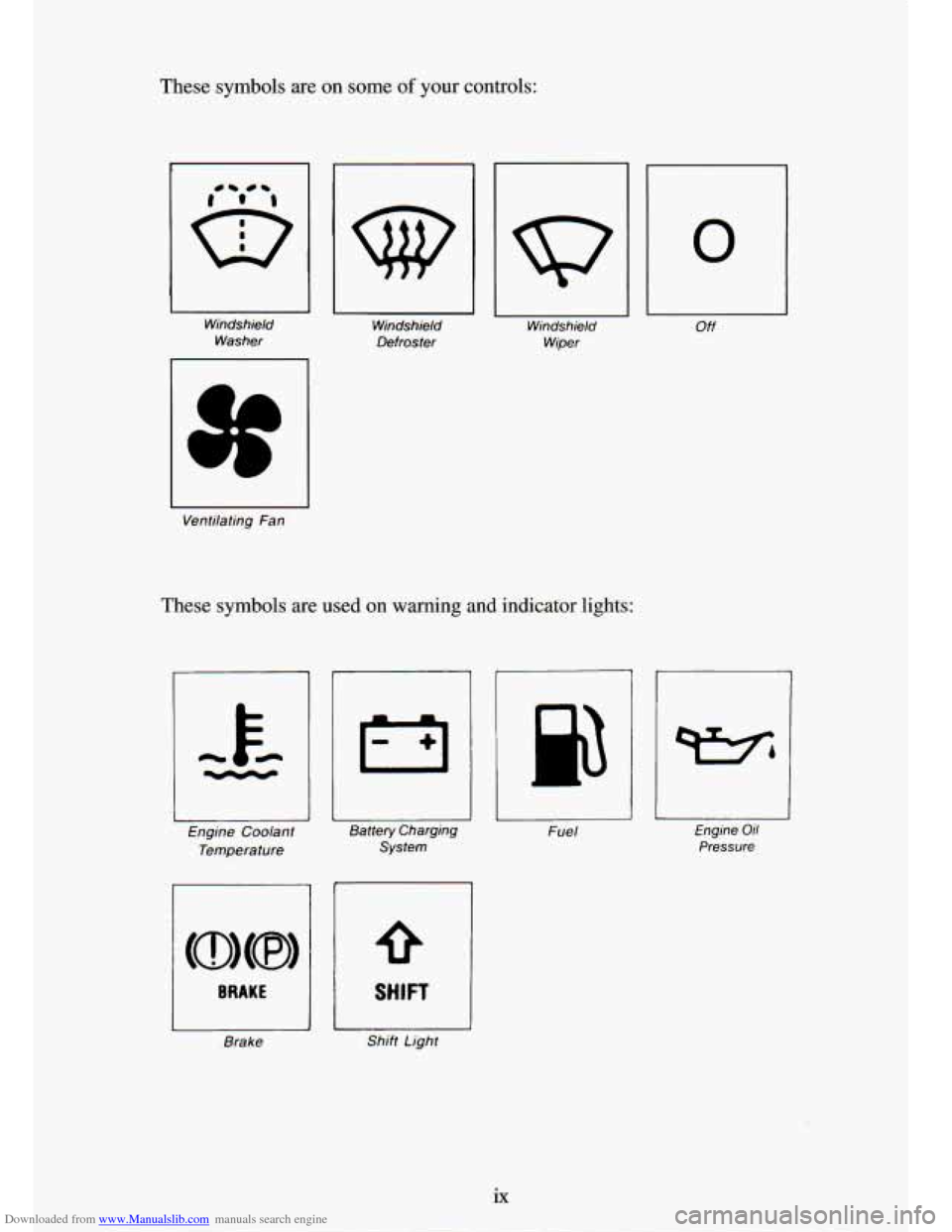
Downloaded from www.Manualslib.com manuals search engine These symbols are on some of your controls:
Windshield Washer Windshield
Defroster Windshield
Wiper
I
Ventilating Fan
These symbols are used on warning and indicator lights:
Engine Coolant
Temperature
BRAKE
Brake Battery Charging
System
I SHIFT
I
Shift Light Fuel
0
Off
Engine Oil
Pressure
Page 47 of 340
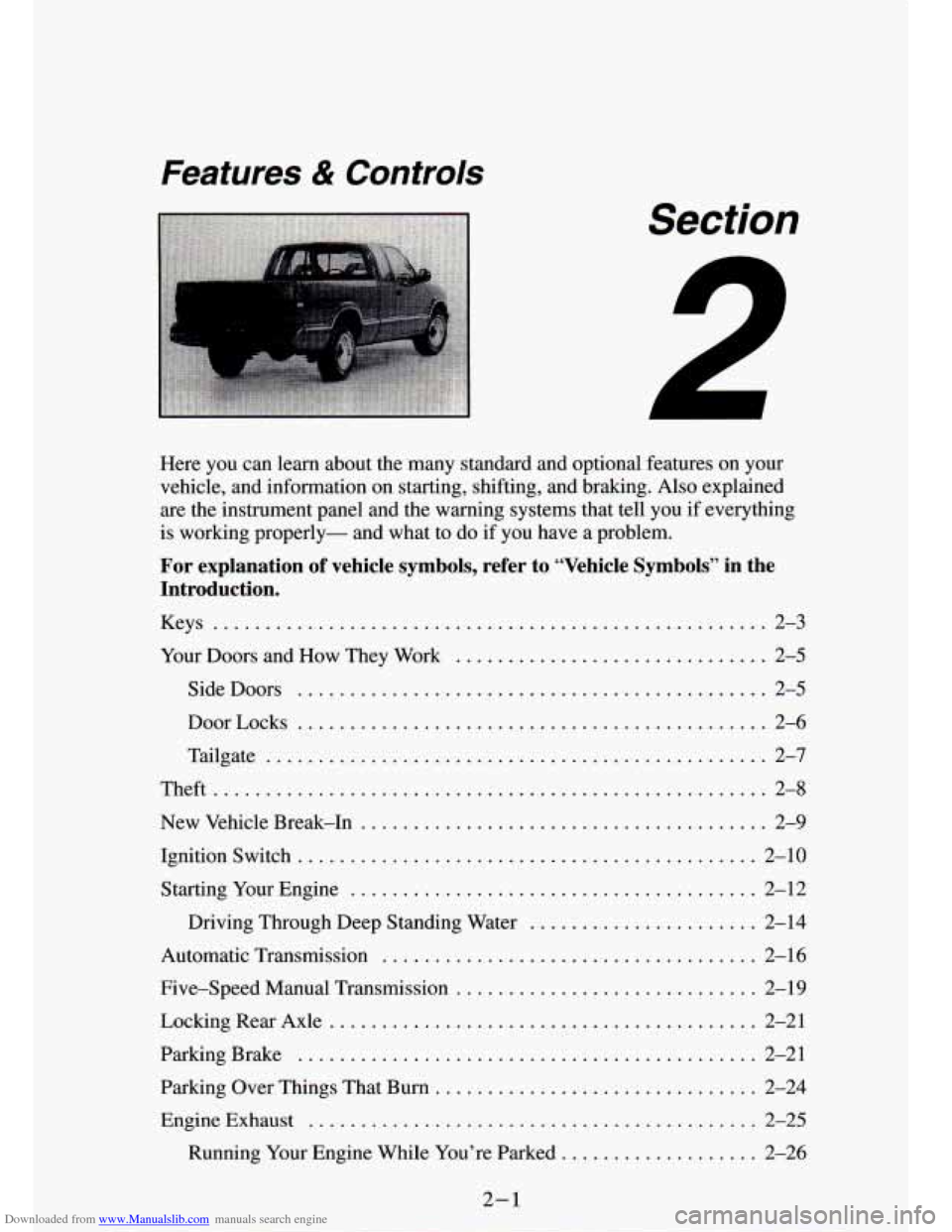
Downloaded from www.Manualslib.com manuals search engine Features & Controls
Section
.
Here you can learn about the many standard and optional features on your
vehicle. and information on starting. shifting. and braking
. Also explained
are the instrument panel and the warning systems that tell you if everything
is working properly- and what to do if you have a problem
.
For explanation of vehicle symbols. refer to “Vehicle Symbols\
” in the Introduction
.
Keys ..................................................... 2-3
Your Doors and How They Work
.............................. 2-5
SideDoors
............................................. 2-5
DoorLocks ............................................. 2-6
Tailgate
................................................ 2-7
Theft
..................................................... 2-8
New Vehicle Break-In
....................................... 2-9
Ignitionswitch
............................................ 2-10
Starting Your Engine
....................................... 2-12
Driving Through Deep Standing Water
...................... 2-14
Automatic Transmission
.................................... 2-16
Five-Speed Manual Transmission
............................. 2-19
LockingRearAxle
......................................... 2-21
ParkingBrake
............................................ 2-21
Parking Over Things That
Burn ............................... 2-24
EngineExhaust
........................................... 2-25
Running Your Engine While You’re Parked ................... 2-26
2-1
Page 55 of 340
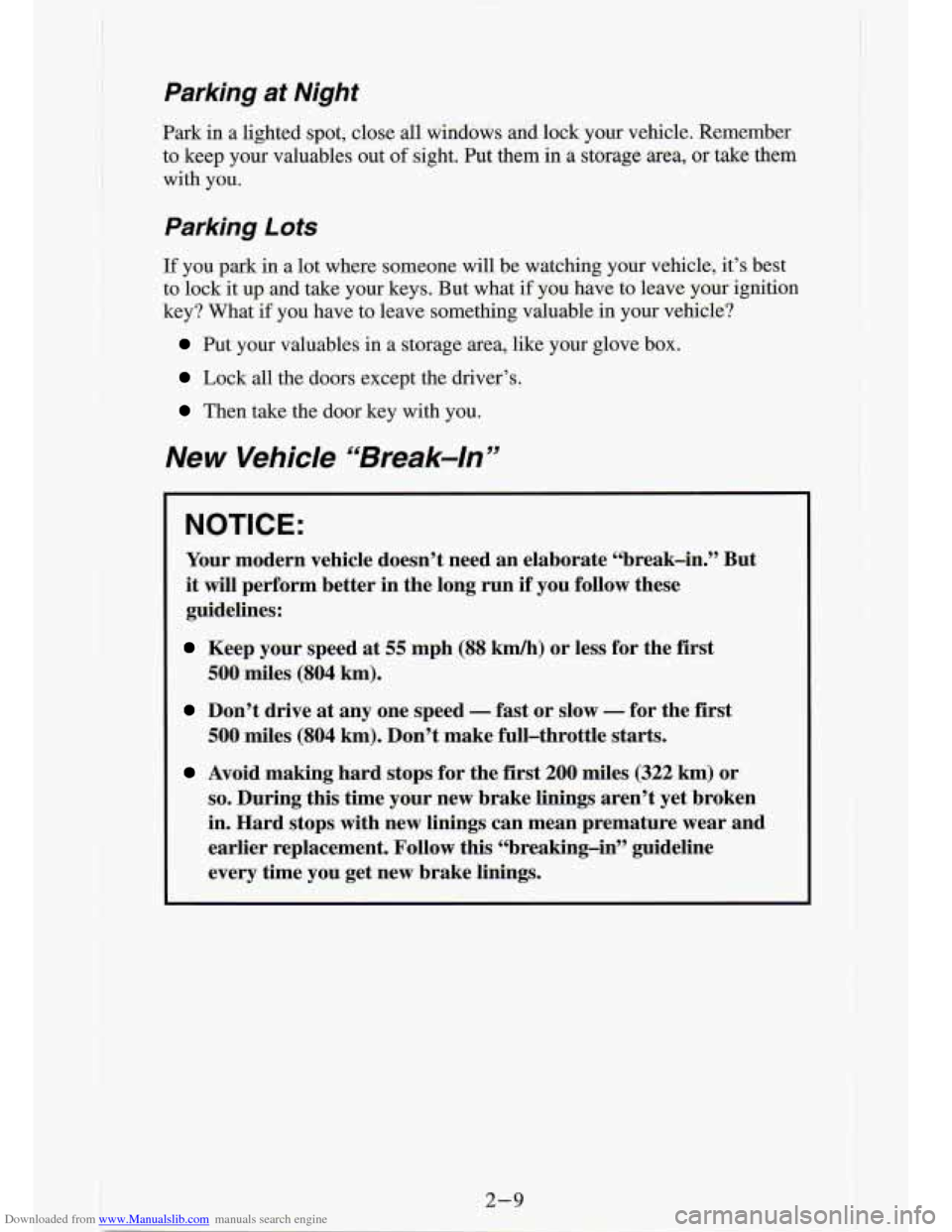
Downloaded from www.Manualslib.com manuals search engine Parking at Night
Park in a lighted spot, close all windows and lock your vehicle. Remember
to keep your valuables out
of sight. Put them in a storage area, or take them
with you.
Parking Lots
If you park in a lot where someone will be watching your vehicle, it’s best
to lock it up and take your keys. But what if you have to leave your ignition
key? What if you have to leave something valuable
in your vehicle?
Put your valuables in a storage area, like your glove box.
Lock all the doors except the driver’s.
Then take the door key with you.
New Vehicle “Break-In”
NOTICE:
Your modern vehicle doesn’t need an elaborate ‘70reak-in.” But
it will perform better in the long run if‘ you follow these
guidelines:
Keep your speed at 55 mph (88 km/h) or less for the first
500 miles (804 km).
Don’t drive at any one speed - fast or slow - for the first
500 miles (804 km). Don’t make full-throttle starts.
Avoid making hard stops for the first 200 miles (322 km) or
so. During this time your new brake linings aren’t yet broken
in. Hard stops with new linings can mean premature wear and
earlier replacement. Follow this “b’reaking-in” guideline
every time you get new brake linings.
2-9
Page 64 of 340
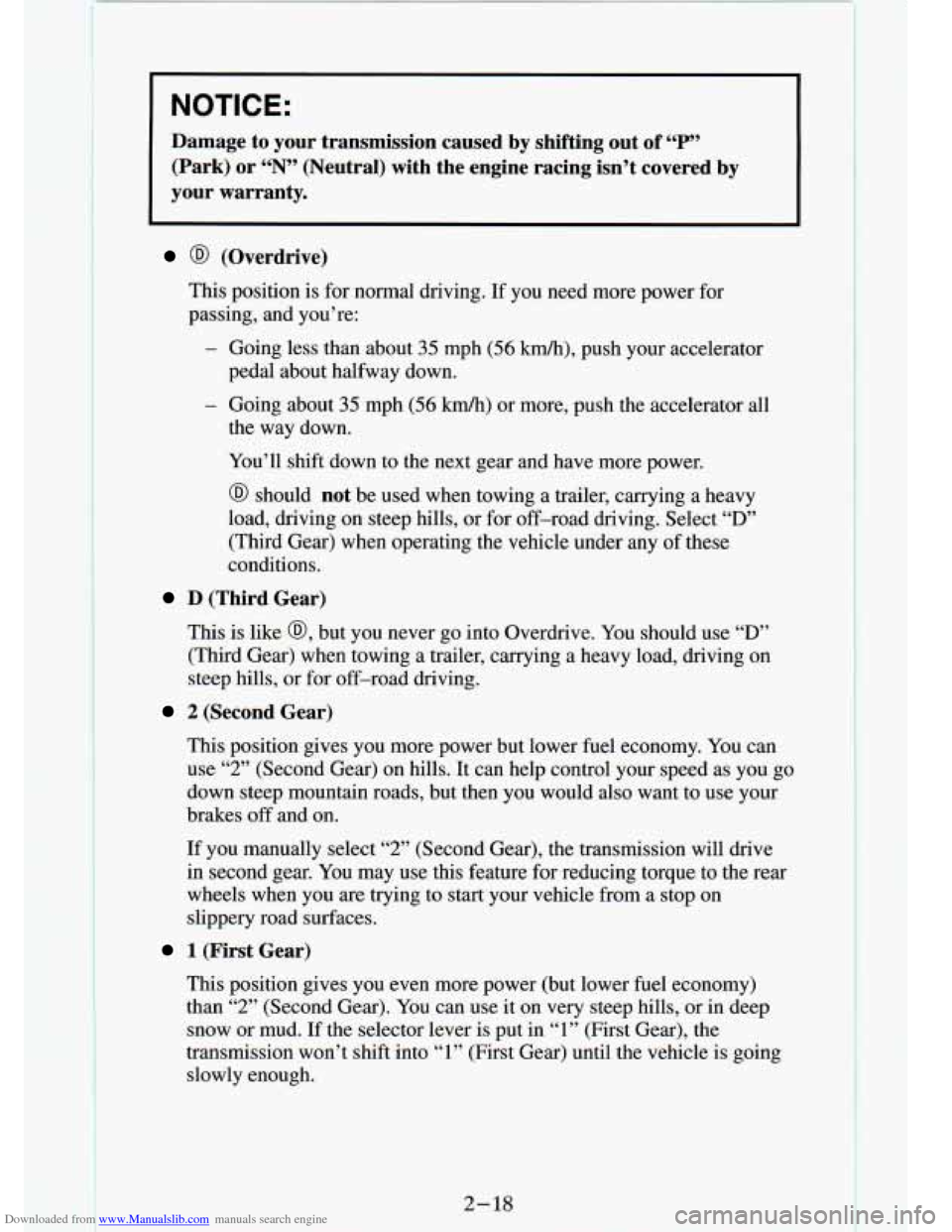
Downloaded from www.Manualslib.com manuals search engine NOTICE:
Damage to your transmission caused by shifting out of “P”
(Park) or “N” (Neutral) with the engine racing isn’t covered by
your warranty.
@ (Overdrive)
This position is for normal driving. If you need more p . rer f_ r
passing, and you’re:
- Going less than about 35 mph (56 ludh), push your accelerator
- Going about 35 mph (56 km/h) or more, push the accelerator all
pedal about halfway down.
the
way down.
You’ll shift down to the next gear and have more power.
@ should not be used when towing a trailer, carrying a heavy
load, driving on steep hills, or for off-road driving. Select
“D”
(Third Gear) when operating the vehicle under any of these
conditions.
D (Third Gear)
This is like @, but you never go into Overdrive. You should use “D”
(Third Gear) when towing a trailer, carrying a heavy load, driving on
steep hills, or for off-road driving.
2 (Second Gear)
This position gives you more power but lower fuel economy. You can
use
“2” (Second Gear) on hills. It can help control your speed as y\
ou go
down steep mountain roads, but then you would also want to use your
brakes
off and on.
If you manually select “2” (Second Gear), the transmission will drive
in second gear. You may use this feature for reducing torque to the rear
wheels when you are trying to start your vehicle from a stop on
slippery road surfaces.
1 (First Gear)
This position gives you even more power (but lower fuel economy)
than
“2” (Second Gear). You can use it on very steep hills, or in deep
snow or mud. If the selector lever is put in
“1” (First Gear), the
transmission won’t shift into
“1” (First Gear) until the vehicle is going
slowly enough.
2- 18
Page 65 of 340
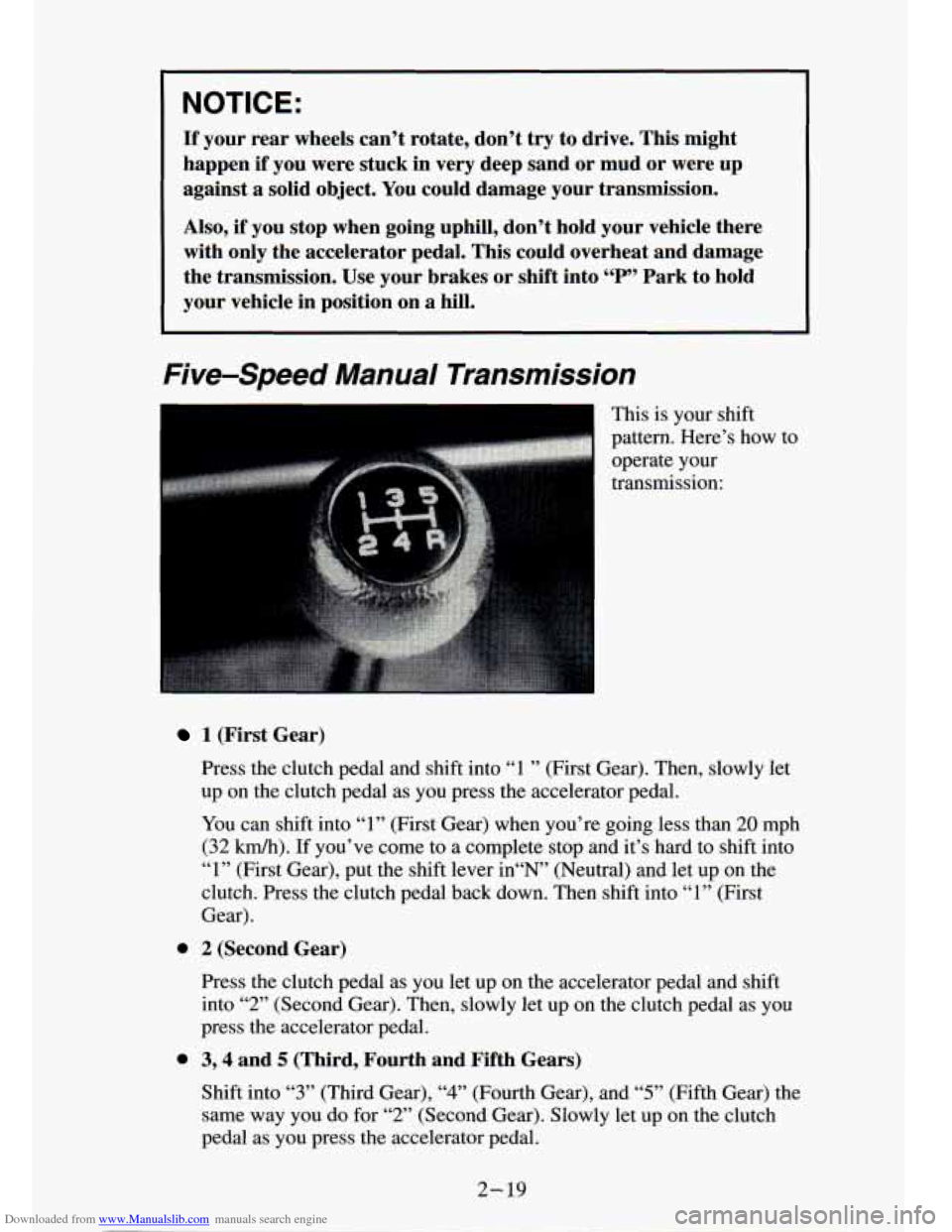
Downloaded from www.Manualslib.com manuals search engine NOTICE:
If your rear wheels can’t rotate, don’t try to drive. This might
happen
if you were stuck in very deep sand or mud or were up
against a solid object. You could damage your transmission.
Also,
if you stop when going uphill, don’t hold your vehicle there
with only the accelerator pedal. This could overheat and damage
the transmission. Use your brakes or shift into
“P” Park to hold
your vehicle in position on
a hill.
Five-Speed Manual Transmission
This is your shift
pattern. Here’s how to
operate your
transmission:
1 (First Gear)
Press the clutch pedal and shift into
“1 ” (First Gear). Then, slowly let
up on the clutch pedal as you press the accelerator pedal.
You can shift into
“1” (First Gear) when you’re going less than 20 mph
(32 km/h). If you’ve come to a complete stop and it’s hard to shift into
“1” (First Gear), put the shift lever in“N” (Neut\
ral) and let up
on the
clutch. Press the clutch pedal back down. Then shift into
“1” (First
Gear).
0 2 (Second Gear)
Press the clutch pedal as you let up
on the accelerator pedal and shift
into
“2” (Second Gear). Then, slowly let up on the clutch pedal as y\
ou
press the accelerator pedal.
0 3’4 and 5 (Third, Fourth and Fifth Gears)
Shift into
“3” (Third Gear), “4” (Fourth Gear), and “5” (Fifth Gear) the
same way
you do for “2” (Second Gear). Slowly let up on the clutch
pedal as
you press the accelerator pedal.
2-19
Page 66 of 340
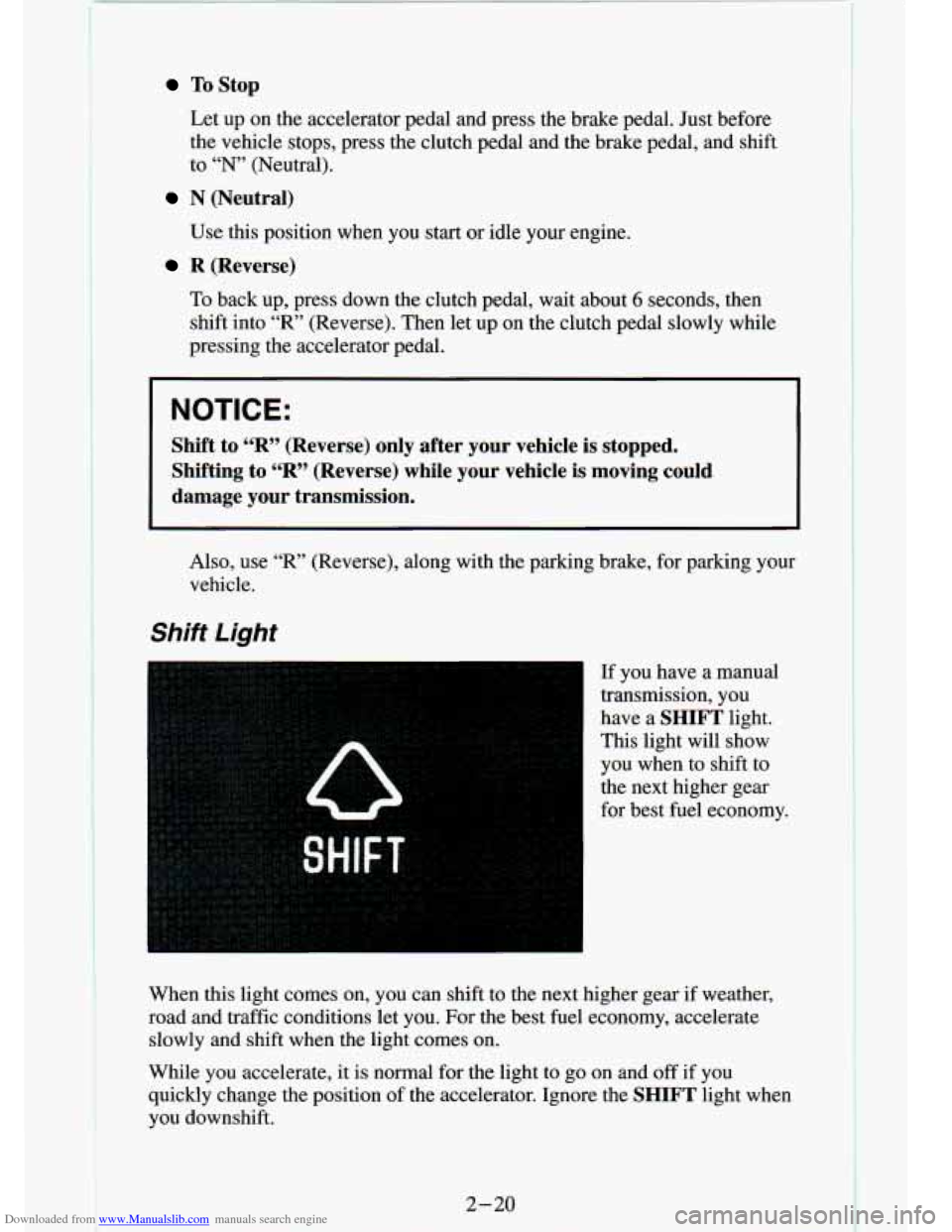
Downloaded from www.Manualslib.com manuals search engine To Stop
Let up on the accelerator pedal and press the brake pedal. Just b\
efore
the vehicle stops, press the clutch pedal and the brake pedal, and\
shift
to
“N’ (Neutral).
N (Neutral)
Use this position when you start or idle your engine.
R (Reverse)
To back up, press down the clutch pedal, wait about 6 seconds, then
shift into
“R’ (Reverse). Then let up on the clutch pedal slowly while
pressing the accelerator pedal.
NOTICE:
Shift to “R” (Reverse) only after your vehicle is stopped.
Shifting to
“R” (Reverse) while your vehicle is moving could
damage your transmission.
Also, use “R” (Reverse), along with the parking brake, for parking your
vehicle.
Shift Light
If you have a manual
transmission, you
have a
SHIFT light.
This light will show
you when to shift to
the next higher gear
for best fuel economy.
When this light comes on, you can shift to the next high€ ;ear if weather,
road and traffic conditions let you. For the best fuel economy\
, accelerate slowly and shift when the light comes on.
While you accelerate, it is normal for the light to go on and
off if you
quickly change the position of the accelerator. Ignore the
SHIFT light when
you downshift.
2-20
F
Page 67 of 340

Downloaded from www.Manualslib.com manuals search engine Four-wheel Drive Vehicles Only: If your vehicle has four-wheel drive
and is equipped with a manual transmission, disregard the shift light when
the transfer case is in
4LO.
Locking Rear Axle
If you have this feature, your rear axle can give you additio\
nal traction on
snow, mud, ice, sand
or gravel. It works like a standard axle most of the
time, but when one of the rear wheels has no traction and the other does, the
locking feature will allow the. wheel with traction to move the vehicle.
Parking Brake
To Set the Parking Brake:
To Release the Parking Brake:
Hold the regular brake
pedal down with your
right foot. Push down
the parking brake
pedal with your left
foot. If the ignition is
on, the brake' system
warning light will
come
on.
Hold the regular brake
pedal down. Pull the
brake release lever.
I
2-21
Page 68 of 340
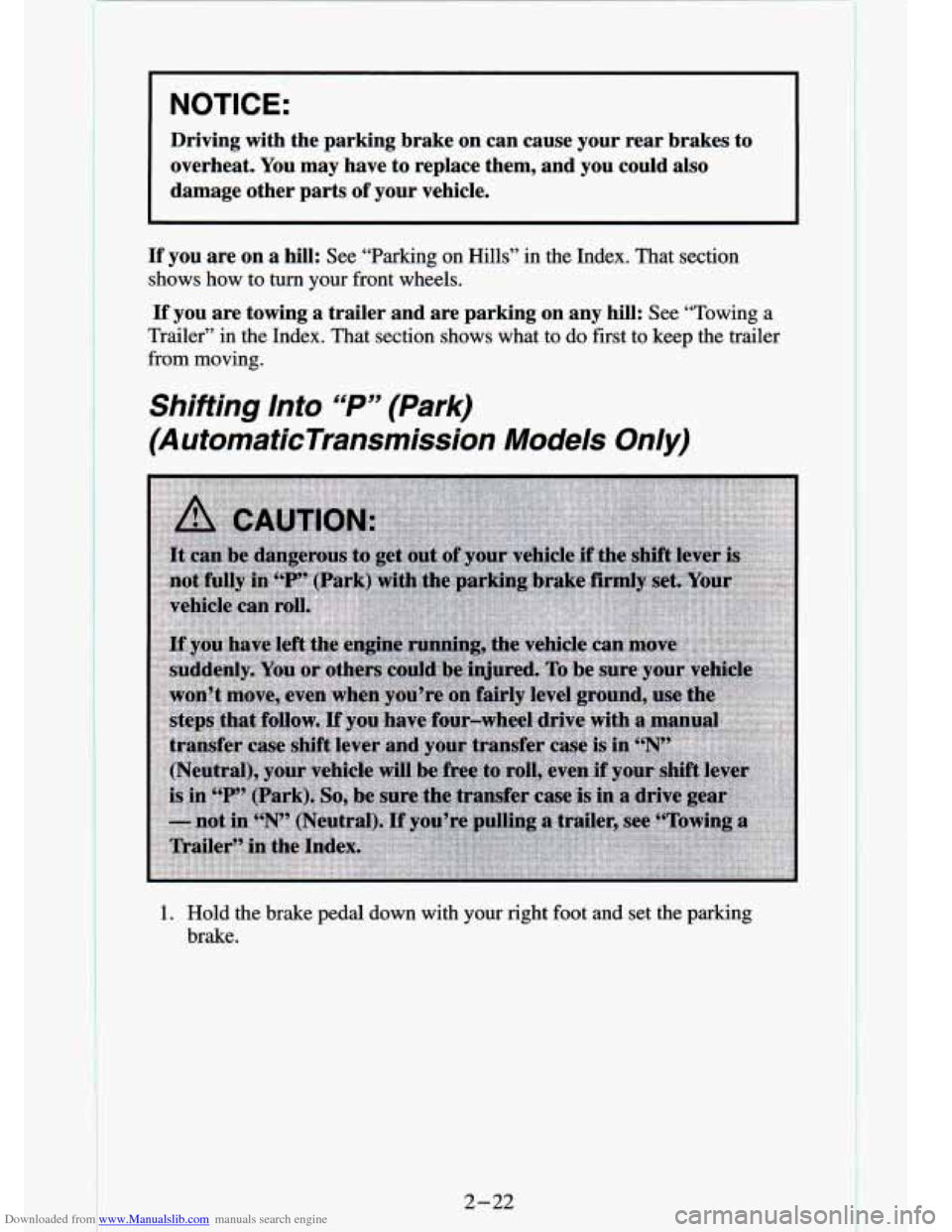
Downloaded from www.Manualslib.com manuals search engine ..
NOTICE:
Driving with the parking brake on can cause your rear brakes \
to overheat. You may have to replace them, and you could also
damage other parts
of your vehicle.
If you are on a hill: See “Parking on Hills” in the Index. That section
shows how
to turn your front wheels.
If you are towing a trailer and are parking on any hill: See “Towing a
Trailer” in the Index. That section shows what to
do first to keep the trailer
from moving.
Shifting Into ‘6P’’ (Park)
(A utomaticTransmission Models Only)
1. Hold the brake pedal down with your right foot and set the parking
brake.
2-22
I I